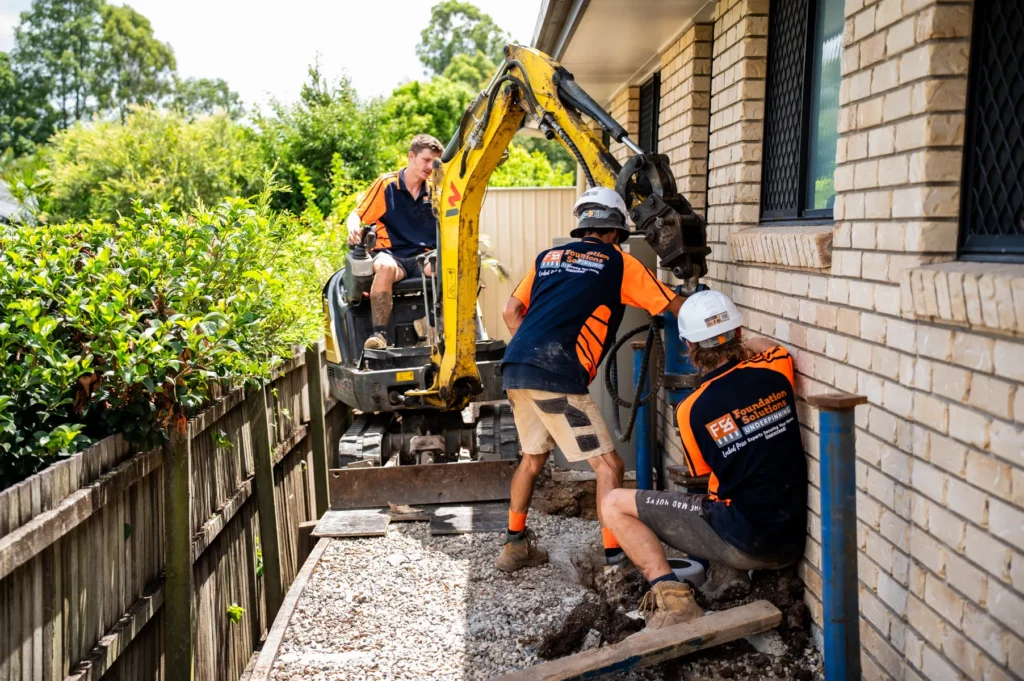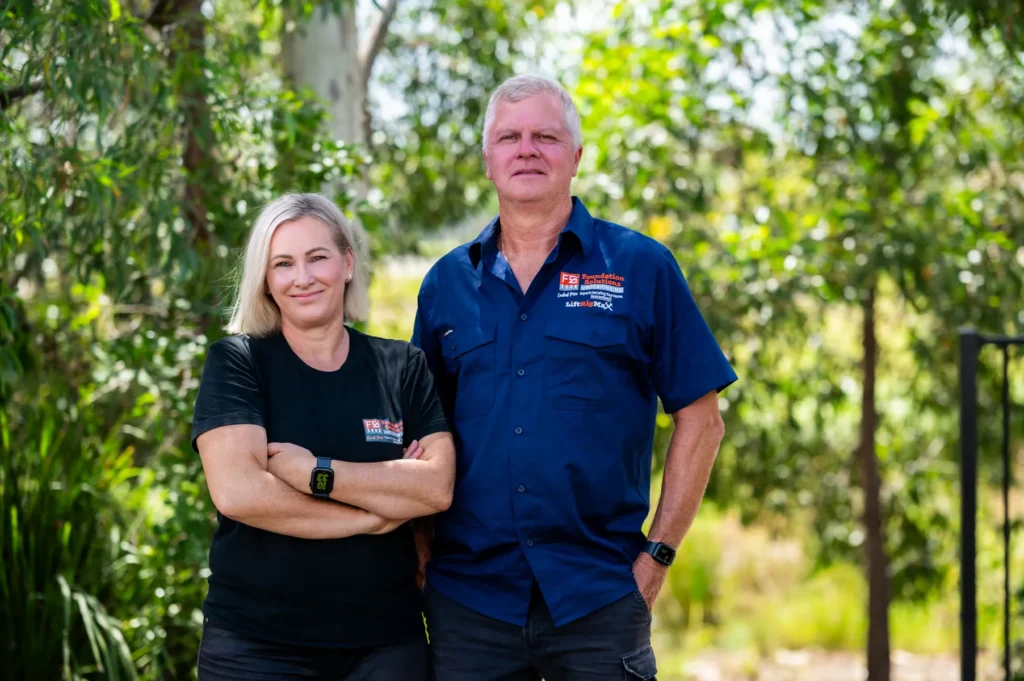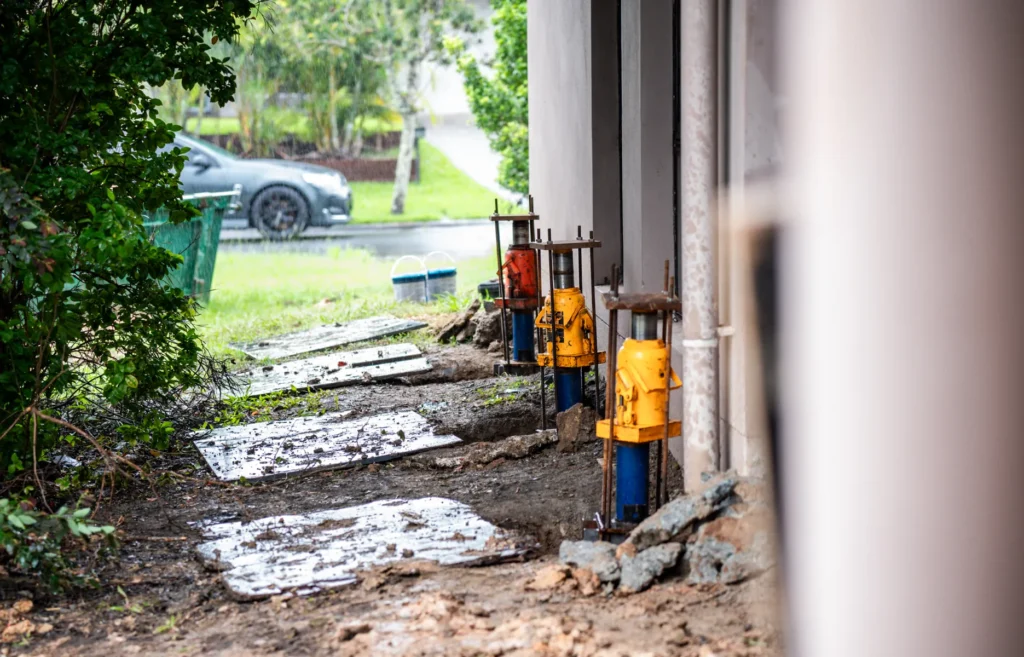Underpinning is the reinforcing of an existing building foundation. It is required when the original foundation is no longer strong enough to support the house. This is usually a result of a change to the soil structure, whether due to the type of soil or some external influence on the soil. Read on for more detailed information.
What is underpinning (of a building)?
Underpinning is the process of supporting or strengthening the foundation of an existing house, building or similar structure. This is accomplished by reinforcing the existing foundation, strengthening the soil by introducing an expanding filler, or extending the foundation so that the load is distributed over a greater surface area.
When is underpinning needed?
For most homeowners, underpinning is required when the original foundation is not strong enough to support the house. This is usually a result of:
- the soil supporting the foundation has changed in some way e.g. through subsidence, expansion/contraction due to moisture, large trees nearby, damaged plumbing left unrepaired.
- the properties of the soil were not adequately understood during the original design of the foundation – meaning the foundation is not adequate for the conditions.
In less common cases, underpinning is also required for the following reasons:
- The way the structure is used has changed e.g. following a major renovation
- New construction nearby resulting in the excavation of soil supporting existing foundations
- To increase the capability of existing foundations e.g. to support another storey to the building
- Natural disasters such as earthquakes, floods or droughts that have caused the structure to move or become unstable.
To help understand if and when underpinning is needed, let’s take a closer look at the key elements that impact a foundation.
Here’s what we’ll cover:
Soil types and site classifications
Types of foundations and footings
Why do building foundations fail?
Types of underpinning
Do I need underpinning?
When to get help?
Do I need a structural engineer?
Will underpinning provide a permanent fix?
Soil Types and Site Classifications
The soil type plays a key role in the stability of foundations. Certain types are prone to more significant structural changes in the soil conditions (e.g. during extended periods of wet or dry weather) and thus contribute to structural foundation problems. We call these soils “reactive”.
The types of soil you have beneath your house will play a part in the extent of damage to your home and the method of underpinning best suited to stabilising the building.
Soils can be classified in a number of ways. When it comes to building foundations, we characterise the soil by the Site Classification (in accordance with Australian Standard AS 2870/2011, Residential slabs and footings). This allows us to understand the soil’s potential to support a structure.
Class A
“Acceptable” 0-10mm Mostly sand and rock sites, with little or no ground movement due to moisture change expected.
Class S
“Satisfactory” 10-20mm Slightly reactive clay sites. Only slight ground movement from moisture changes expected.
Class M / M-D
“Moderate” 20-40mm Moderately reactive clay or silt sites which can experience moderate ground movement from moisture changes.
Class H1 / H1-D
“Highly Reactive” 40-60mm Highly reactive clay sites. Can experience high ground movement from moisture changes.
Class H2 / H2-D
“Highly Reactive” 60-75mm Highly reactive clay sites. Can experience very high ground movement from moisture changes.
Class E / E-D
“Extreme” 75mm+ Extremely reactive sites. Can experience extreme ground movement from moisture changes.
Class P
“Problem” Sites which include soft soils, such as soft clay or silt or loose sand, varying depths of fill, landslips, mine subsistence, collapsing soils, soils subject to erosion, reactive sites subject to abnormal moisture conditions, or sites which cannot be classified otherwise.
The “D” inclusion in the above classifications refers to ‘deep’ movements in soil due to deep variances in moisture. These classifications are mostly found in dry areas.
Types of building foundations and footings
Technically speaking, the “foundation” is the earth or strata, upon which the “footings” for a building are constructed. However the word “foundation” is regularly used today in Australia to refer to the “footing system” and the “flooring system” that together make up the foundation.
In residential construction, there are 2 common flooring systems used:
Slab on Ground
There are several types of slab on ground foundation, such as a raft slab, waffle pod slab, slab with dropped edge beams or a reinforced slab on fill. These are the typical foundation systems which have been in use for many years in Australia, particularly QLD and NSW.
Suspended Floors
These foundations are most commonly framed with stumps or piers, and are supported by bearers and joists.
The footing systems used commonly in residential construction consist of:
Continuous footings
Such as a concrete strip or slab used to support uniformly distributed loads.
Pad footings
Such as a square or round concrete pad used to support a concentrated load. Most commonly used in conjunction with stumps.
Stumps
Designed in hollow steel or timber poles or machined timber posts.
Piles and Piers
Like stumps, but driven or bored into the ground. Commonly used where additional support is required. Includes poured concrete piers, bored piers, driven piles (timber, steel, concrete), and steel screw piles.
Underpinning is most commonly carried out on “Slab on Ground” type foundations.
Why do building foundations fail?
There are several reasons why the foundations on a building might fail.
Reactive Soils
Most frequently the problem relates to the movement of highly reactive soils. This movement involves shrinkage (which leads to settlement) or expansion (which causes heaving). When dry conditions persist, soils gradually lose moisture and shrink. When moisture levels are elevated, such as during extended periods of wet weather, soils swell – sometimes by several hundred percent.
Both shrinkage and expansion of soil can compromise the integrity of the foundation, resulting in heaving, subsidence, and visible cracking in foundations and walls.
Poorly Compacted Fill
If a site was subject to fill, sometimes the material used is not sufficiently compacted to support the weight of the structure above it. In these cases, foundation problems often occur. The problem can originate from poorly compacted fill, the use of multiple fill materials, or both.
Site Erosion
Erosion can wear away the soil around foundations, to the extent that foundations become structurally compromised. Erosion can originate from a number of sources, such as a burst water pipe or other uncontrolled water flow, inadequate drainage, or the like.
Slope Failure
Failure of a slope relates to the movement of earth downhill. It could involve slow failure, known as “creep”, or sudden failure, which are “landslides”. Where a slope is failing due to creep, underpinning can be used to rectify the problem. However, this is very site specific and requires an expert assessment.
Transpiration (aka Trees)
Trees are a significant factor in foundation failure. All plants remove moisture from the soil. This is known as transpiration. Large trees removing moisture from the soil can significantly accelerate soil shrinkage. When trees are located too close to buildings, this can lead to the expansion or shrinking of soils enough to compromise the foundation.
Foundation Design
To a lesser degree, the design of the original foundation may have been inadequate. This could be due to the soil properties not being adequately understood during the original design of the foundation – meaning the foundation is not adequate for the conditions. However, due to modern building codes, this is less of an issue.
Types of underpinning
As we mentioned earlier in the article, underpinning refers to the reinforcing of an existing foundation.
When it comes to repairing the foundations on buildings with stumps, the method used is referred to as restumping or reblocking. Essentially this involves replacing the foundation stumps when they are cracked or otherwise damaged. This is not considered underpinning.
Within this definition of underpinning, there are three methods in use today:
- Concrete slab
- Screw pile
- Grout or resin injection
Historically there have been two main underpinning techniques in use. These are concrete slab underpinning (also known as slab jacking) and screw pile underpinning (also known as pier underpinning or piering). More recently a third method is being used called grout or resin injection.
Concrete slab
Traditionally, concrete underpinning was used to increase the size of foundations and in the process strengthen them. It is still used a lot today.
Screw pile
This is the method used by Foundation Solutions, which combines steel piers with concrete footings to secure the building and lift is back to its original position, closing up gaps and cracks. The use of piers is considered a permanent solution – one that will not be affected by further changes in the ground surrounding the house – which is why we use this method.
Grout / Resin injection
This is the newest method available, though it is not actually underpinning. It involves injecting resin or grout into the ground which fills up voids under the slab and expands, compressing the ground. It is the least quantifiable method, in terms of permanency of repair and the final cost (the amount of grout required can’t be accurately predicted and regularly blows out beyond initial estimates) and it not suited to all ground conditions.
Do I need underpinning?
There are some indicative signs to look for when doing a DIY evaluation of your own property. When reading through this list, it is important to understand that subsidence occurs on many properties to varying degrees. Underpinning is only required where subsidence is actively occurring. Sometimes after subsidence initially occurs, the structure reaches a state of equilibrium and there is no further danger. As always, if you are unsure, it is best to ask a professional – which is why we provide a complimentary Home Checkup service.
Cracks in floors or walls
Cracks aren’t always scary. Sometimes they are superficial, such as minor or hairline cracks in plaster, cornices and skirting boards. Bigger cracks are another story and usually point to bigger underlying problems, such as uneven weight distribution due to weak foundations.
Cracks to look for could be interior (plaster, wall and floor tiles) or exterior (brickwork, render, concrete slab).
Ideally try to observe the cracks over a period of weeks or months to determine if the cracks you’ve noticed get bigger, wider or longer – or if new cracks appear. If they remain unchanged over a long period, the subsidence has likely run its course and the house has settled.
Floor not level
Something that isn’t always as obvious as cracks is unlevel floors. When you are able to identify them however, a lean to one or more sides of your home is a strong sign that there are significant foundation issues at play.
In serious cases we’ve seen, you can stand at one end of a hallway and see the fall of the house as you look down the hall. Other times, unlevel floors will contribute to misaligned doors. Generally you can use a spirit level to get some idea of how unlevel a room is. Or place a ball in a room and see if it remains still or if it rolls in a particular direction. But to understand how significant this is usually will require a professional.
Another thing to look for are irregular trenches forming around the edge of the building or slab, in the top layers of the soil. This is another sign of subsidence.
Doors and windows out of alignment
Doors and windows can be good indicators of foundation problems. Gaps appearing and getting wider around your windows and doors. Finding it hard to close (or reopen) your doors or windows, or not being able to lock them.
In more advanced cases, there are more visible leans to door, and door or window frames may begin pulling away from their surrounding walls.
When to get help
None of the above indicators are guarantees that you will require underpinning. But at the same time, you don’t want to do is wait around until the symptoms become severe. If after doing a DIY assessment of your home you have concerns, the best thing to do is remain calm – there is plenty of help available.
The first step would be to do a bit of research (perhaps that’s why you’re on this page now). Don’t limit it to internet research though. Pick up the phone to a few people willing to provide helpful advice and get their opinion on the situation.
If the feedback you’re getting is that you may indeed have a problem that requires an underpinning fix, get someone to come to your home to investigate firsthand. For this purpose we provide a complimentary Home Checkup service that is an excellent first step and avoids you having to fork out money on engineers when they may not be needed.
The other key thing to consider when getting help is the cost. There are many contractors out there, so get more than one opinion and more than one quote. In the process you will also get a feel for the people you’re dealing with and are able to decide who you feel most comfortable dealing with. We have a separate article that looks in detail at how much underpinning should cost.
Do I need a Structural Engineer?
When we do our Home Checkups, one of the things we do is determine if a structural engineer (aka forensic engineer) is required to do a more detailed assessment of the site. We have our own structural engineers we use, so you don’t need to ring around to get separate quotes.
Will underpinning provide a permanent fix?
The answer to this will ultimately depend on the soil your home is sitting on (the site classification) and the type of underpinning service you choose to remedy your problem.
Not all types of underpinning are suited to all foundation problems. When we do our complimentary home checkups, we let you know up front if our method of underpinning is able to provide a permanent fix for you. If not, we won’t quote you and will recommend an alternate course of action.
The reason we exclusively use screw pile underpinning is because it is the most reliable underpinning method available.
Do you need an expert assessment?
If you have any uncertainty, why not book in a Home Checkup with one of our experts. Or if you just want to pick our brains a bit, then pick up the phone to us now. We will be more than happy to help.



